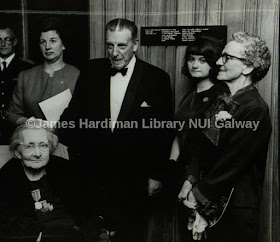Across the weekend a diverse programme of cultural commemoration in the form of lectures, talks, concerts, exhibitions and re-enactments entertained and engaged the public. At the beginning of all these events was a laying of a wreath at the Garden of Remembrance at Parnell Square by President Higgins.
The Garden of Remembrance was officially opened by then President of Ireland, Éamon De Valera, as part of the fiftieth anniversary commemorations of the 1916 Rising in 1966. As the events of 1916 are of such interest to study and understand, so too are the acts of commemoration and understanding how we remember these moments in Irish history at various times in the State's history. Within the archive of actor and revolutionary Arthur Shields at the Hardiman Library, NUI Galway, are original plans for the Garden of Remembrance. Arthur was an actor and stage manager at the Abbey Theatre and who was an active combatant in the Rising as it broke out just streets away from the Abbey Theatre. He was later arrested and interned at Frongoch Prison Camp in Wales.
In a further link between history and remembering, Shields has the unique distinction of being a rebel active in 1916, of playing the lead role of Jack Clitheroe in the 1926 original production of Sean O'Casey's "The Plough and the Stars" critiquing the Rising at the Abbey Theatre and also playing the role of Padraic Pearse in the 1936 film version of "The Plough and the Stars" directed by John Ford with a screenplay by Dudley Nicholas. The below images are all from the archive of Arthur Shields and offer a glimpse into commemorations of 1916 fifty years ago.
 |
| Original plans for the Garden of Remembrance |
 |
| A book of commemorative stamps issued by An Post |
 |
| A book of commemorative stamps issued by An Post |
 |
| A photograph of Arthur Shields (centre) as a fallen rebel from the 1926 production of "The Plough and the Stars at the Abbey Theatre |








